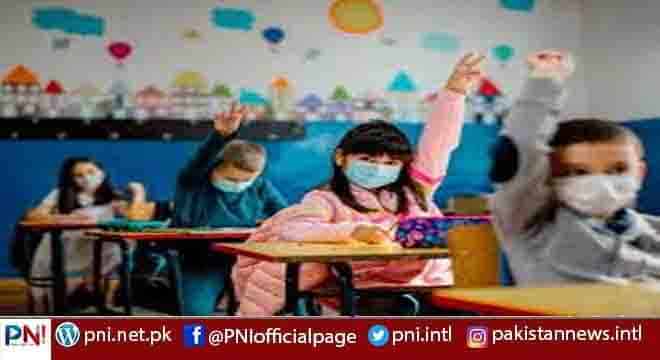ISLAMABAD, June 23 (Online): Just when most Americans have tucked away their stash of masks, some parts of the country are requiring that they have them at the ready once again.
For instance, in early June, Alameda County in the San Francisco Bay area reinstated a mask mandate in most indoor spaces after hospitalizations due to COVID-19 increased by 35 percent.
While Alameda exempted schools from the mandate, at the end of May, neighboring Berkeley Unified School District decided to only require masks in schools.
In New York City, a mask mandate for toddlers ages 2 to 4 who attend day care and preschool ended June 13.
To confuse things further, there was a short-lived four-day indoor mask mandate in Philadelphia last spring that ended after the city’s health department cited improving conditions.
And of course, at the moment, different rules are in place at various airports across the U.S. Masks are required in the Los Angeles Airport but not at Orlando International Airport, for instance.
With the lack of consistency across the country and even within the same states and local jurisdictions, there’s no surprise that Americans are confused and losing trust in public health.
“Frequently changing public health policies are definitely confusing, especially if you don’t have public health training, which most of the world does not have. It is our job as medical professionals to take the data and translate it for our patients and community members,” Dr. Alexa Mieses Malchuk, assistant professor of family medicine at the UNC School of Medicine, told Healthline.
Lack of clear communication from public officials is exactly the issue, according to Dr. William Schaffner, professor of preventive medicine and infectious diseases at Vanderbilt University Medical Center in Nashville.
“Part of the reason is that when COVID first came on the scene, instead of having a national policy, our political leadership said, ‘I’ll leave it to the states’ and the moment they did that we had different governors saying different things and that leads to confusion because we didn’t have a national policy,” Schaffner told Healthline.
While he stressed that public health measures shouldn’t be identical in states like Maine and New Mexico, he said there should be some cohesion. Consider how an orchestra works.
“It has a lot of different instruments and the brasses don’t always play the exact same notes as the strings, but they are all playing from the same sheet of music. They have one conductor and from that, they are harmonizing,” he said. “We never had that in this country with COVID and we still don’t have it within in states.”
Still, it’s the job of public health officials and the medical community to communicate clearly what is occurring and what is needed to stay safe.
“We are the bridge. Spreading medical misinformation is unethical,” said Mieses Malchuk. “It’s also important to remember that public health policies change often based on new scientific data that become available. This can be frustrating… but we must remain flexible.”
Communication isn’t the only issue, though, according to Dr. Monica Gandhi, professor of medicine at University of California, San Francisco.
She said scientists and doctors don’t agree on how best to manage the pandemic at this point, and believes the key to restoring harmony within the medical community and the country is to eliminate mask mandates.
A recent New York Times article that shed light on the mask debate, made its way into a public Centers for Disease Control and Prevention (CDC) briefing with the Senate in June.
“I really supported masks early on and wrote seven or so papers on that, but I am also able to re-evaluate the data as we go along,” Gandhi told Healthline.
Current data on mask effectiveness surprised her as it showed that mask mandates did not make a difference.
“We didn’t see that major of a difference with transmissions,” she said. “The strongest predictor of how places did was vaccination rates.”
Why are COVID-19 measures still in place?
The omicron variant and its subvariants are now the dominant COVID-19 strains and are spreading widely, said Schaffner.
“That’s because these variants have the capacity to infect people who were fully vaccinated and even people who have recovered from previous COVID.
Now when that happens, in the vast majority of instances, you get relatively mild symptoms that don’t require you to be in the hospital,” he explained.
Because people survive the virus, they continue to spread it to people who are unvaccinated, who are partially vaccinated, or those who are immunosuppressed and do not respond well to the vaccine.
“Those are the people now who are being hospitalized,” said Schaffner.
The 7-day daily average of new COVID-19 hospitalizations for June 1–7 was 4,127, which is an 8.0% increaseTrusted Source from the prior 7-day average, according to the CDC.
However, those who are admitted to the hospital with omicron are in the hospital for a shorter time and have less frequent admission to intensive care compared to those hospitalized with other coronavirus variants, according to researchers at the CDCTrusted Source.
“It’s a little bit confusing: the virus is spreading, vaccine provides protection against severe disease, but not very much protection against mild infection. So, cases are increasing and hospitalizations are a little in some areas. But for the most part, COVID is causing milder illness and [in turn] is continuing to spread,” said Schaffner.
In health jurisdictions and schools, local authorities may evaluate the spread and decide to reinstitute mask recommendations or mask mandates.
“This is not going to be uniform, which will lead to inconsistency throughout the country,” Schaffner said. “It’s often the case that public health officials look at the data and then they say, ‘we know what will be ideal, but here’s what our population will accept.’”
For example, during the early parts of the pandemic in Tennessee, the governor permitted individual cities to make their own rules on public health measures but did not impose a statewide mandate. This led to mask mandates in cities like Nashville and yet across the county line, no mandates were in place.
“A lot of debate and confusion occurred. You see similar things happening locally because no matter what the public health people say, the school board, the mayor, the county commissioners have to consider what’s acceptable to their local population, and that can change from location to location within the same state,” said Schaffner.
This is where political pressure can take root and cause inconsistency in public health initiatives.
“When things change based on political rhetoric rather than science, this can erode the public’s trust in the medical and public health communities,” said Mieses Malchuk.
But so can being unclear about data, added Gandhi.
“If we have really high cases right now, say more than what’s being recorded because people are doing home tests, and we have such low hospitalizations and deaths that continue to fall, that degree of immunity shows we are at a better point in the pandemic than we’ve ever been,” she said.
At this stage of the pandemic, Dr. Jeanne Noble, an emergency care physician and director of COVID-19 response at UCSF, said mandates are counterproductive.
“COVID is endemic and will continue to ebb and flow with or without mandates. As the entire population acquires natural or hybrid immunity, the peaks will become less and less noteworthy, a process which is already well underway,” she told Healthline.
Follow the PNI Facebook page for the latest news and updates.








